When nature calls: Pursuing Research in the perfect setting
MSU provides students with unique hands-on opportunities to explore nature's bounty. And many of these next-generation scientists are unearthing ways to protect and preserve Michigan's natural resources.

Boasting more than 18 million forest acres, 49,000 miles of rivers, some 35,000 inland lakes, countless wetlands, marshes and swamps, 200,000 acres of sand dunes and the world’s largest surface freshwater system — the Great Lakes — Michigan has an impressive list of natural resources. Add in the wide variety of microclimates and an abundance of wildlife species — from tree frogs to American black bears — and the state quickly becomes an ideal living laboratory for scientists and the students following in their footsteps.
Michigan State University (MSU), the nation’s pioneer land-grant university, provides students with unique hands-on opportunities to explore nature’s bounty. And many of these next-generation scientists are unearthing ways to protect and preserve Michigan’s natural resources.
Assessing habitats in young forests
For more than 160 years, northern Michigan’s timber industry has supplied raw materials used to create many products, including homes, furniture, paper and renewable fuel. The harvesting, however, has been associated with declines of various wildlife species because of changes in the forest habitats. In response, the Michigan Department of Natural Resources (DNR) has issued several operational guidelines for timber harvests on state-owned land. These DNR guidelines encourage harvesters to leave 3 to 10 percent of the land untouched for wildlife habitat.
While working on doctoral degrees from the MSU Department of Fisheries and Wildlife, and the Ecology, Evolutionary Biology and Behavior Program in 2012 under the guidance of MSU assistant professor Gary Roloff, Clint Otto wanted to examine the impact of habitat retention on songbirds and salamanders in harvested forest stands. Otto said he chose those species because they are akin to “canaries in a coal mine,” meaning that their presence - or absence - is a good indicator of the health of the environment.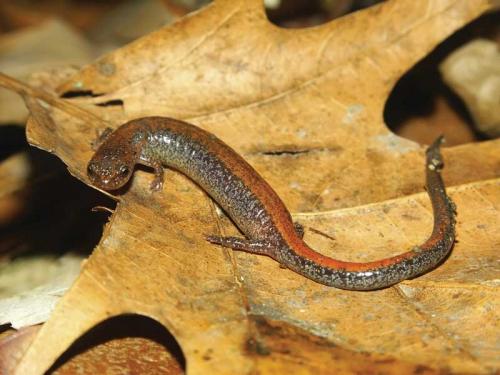
“Wildlife biologists have long recognized that, even in clearcut areas, you can leave green structures behind to encourage use by various wildlife species,” Otto said. “I wanted to determine whether areas with more structural retention were used more often by forest-dwelling wildlife than areas with less structural retention. I also investigated how early successional songbirds respond to structural retention, and conducted an in-depth investigation of whether structural retention reduced red-backed salamander mortality in recently harvested forest stands.”
Otto determined that the amount of habitat retention did not play a significant role in attracting forest-dwelling songbirds to recently harvested forest stands. Instead, many young songbirds selected habitat sites based on the age of the trees rather than the availability of green structure.
“We initially predicted that forest songbirds would utilize clearcut patches with higher levels of structural retention than patches with lower levels,” he said. “However, after conducting the research, we found no difference in the use of stands that had a lot of structural retention versus those with little or no retention.”
He noted one exception to this finding: the red-eyed vireo, a mature forest bird, utilized forest stands with more structural retention.
“We also predicted that early-successional songbirds, such as chestnut-sided warblers, would show decreased use of clearcut patches with lots of structural retention,” he added. “However, our field data did not support this hypothesis. We observed consistent use of forest patches within young stands with varied levels of structural retention by all of the early-successional songbird species.”
Overall, Otto concluded that structural retention didn’t promote use of clearcut areas by mature forest birds. The retention also didn’t affect the early-successional songbird species, which continued to use the space despite a natural tendency toward other types of habitat conditions.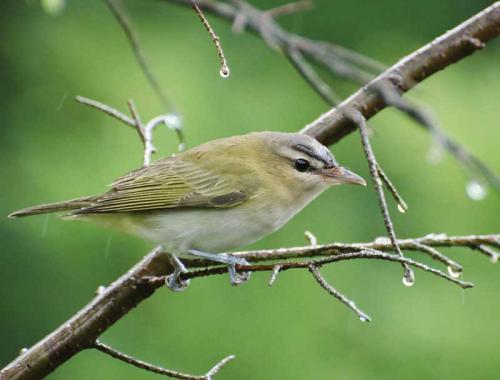
To test the effect on salamanders, the team set up enclosures with varying amounts of structural retention in recently harvested forest patches and placed 10 marked salamanders into each. At the time, it was not known whether structural retention provided adequate microhabitat and reduced or prevented mortality of salamanders, which rely on protective groundcover to prevent dehydration in the summer heat.
“We found exactly what we expected: in spots where there was a lot of retention, more salamanders lived than in those sites where all the harvest materials were removed from the forest stand,” he said. “However, when we scaled-up our study and looked at the total distribution of salamanders within clear-cut areas, we found a nearly equal distribution of salamanders between sites regardless of how much structural retention was left.”
Otto and his team wondered why they had observed such a strong, positive benefit of structural retention at the small scale but not on the large one.
“I think this discrepancy highlights the importance of using multiple approaches to tackling any scientific problem,” he said. “This ensures we get results that tell us the complete story and ultimately lead us to the strongest conclusions.”
His research has helped inform the DNR.
“They called on us to provide unbiased information so they could adapt their management,” he said. “This partnership between scientists and natural resource managers represents a great team effort. The Michigan DNR operates with a limited budget, but they chose to invest in this research because they have a genuine interest in knowing if their management practices are effective.”
Otto graduated from MSU in 2012 and is currently a research ecologist for the U.S. Geological Survey at the Northern Prairie Wildlife Research Center in Jamestown, North Dakota.
Preserving trout resources in Michigan
MSU Department of Fisheries and Wildlife master’s student Elle Gulotty also had an interest in studying the effects of Michigan’s historical timber and logging industry. She has been examining the Au Sable River and the impact of tree removal along the banks to move the logs downstream on the river’s trout population.
The 138-mile river flows from Grayling to Oscoda and serves as an important energy source (it houses six hydroelectric dams) as well as a place for outdoor recreational opportunities -- fly-fishing is one of the most popular. Beginning in the 1930s with the Civilian Conservation Corps, local anglers, conservation groups and state agencies have made a long-term commitment to improving river habit by placing various structures in the north branch of the river. Their efforts continue today.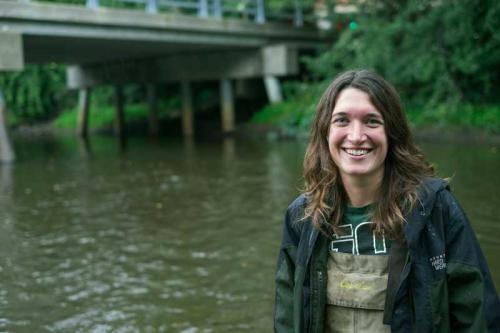
“Some of these structures were meant to provide adult trout cover (from avian predators, for example) en route to spawning beds,” she explained. “Others were placed in hopes of influencing stream dynamics in a manner favorable for the trout, such as causing scouring and increased non-uniformity of depth and substrate. Some of these structures seemed to work well, but others didn’t. But across them all, there was a need for a formal evaluation of their success and how these structures affect the flow of the stream.”
Gulotty is working under the guidance of MSU AgBioResearch professor Daniel Hayes to document the varying densities and types of structures in the river’s north branch. It is part of a field of study known as fluvial geomorphology, which includes the examination of rivers in their natural states and in response to human-induced changes in the watershed. Her findings will help natural resources managers fine-tune the placement of these structures and provide data on the efficacy of their use.
The team divides the river into cross-sections based on the location of habitat structures. At those sites, they map the habitat, the structures and the structures’ effect on water depth, discharge and velocity.
“We found that some of these structures mostly provide an area where fish can hide. Others provide a few feet of cover and then a much larger swath of silt falling because this stream is pretty low power,” she explained. “Those metrics are important when you’re trying to determine what is needed to recruit fish to an area of the river and what type of structures are best suited for the specific conditions of certain sections of the river.”
Gulotty then assessed the general fish population, including the trout.
“We can put all of these findings together to tell us what’s going on in the river, how the structure influences the fluvial geomorphology, what fish species are present and what trout species are present,” she said. “Taking these measurements gives us the whole picture.”
Working closely with local conservation Groups -- such as the Anglers of the Au Sable and the Kalamazoo Valley Chapter of Trout Unlimited -- and government agencies, Gulotty has been afforded a unique opportunity to learn about the importance of collaboration.
“Contrary to some other systems I’ve worked in, there’s very strong community support for the river,” she said. “People in the area love this river and are active stewards of this resource. They’re passionate about it, they’re knowledgeable, and we’ve been able to partner with them and seek their input. From locals and conservation groups to folks from the DNR and the Michigan Department of Environmental Quality — all of them have helped us better understand this system.”
And Gulotty feels especially fortunate to have worked with Hayes.
“There is cooperation between really passionate and bright people I wouldn’t have had access to if it weren’t for meeting and working with Dr. Hayes,” she said. “There is an onus on me to try to live up to the standard he sets. If I could continue in the direction his past students have gone, I would be very satisfied with my contribution to the resource.”
Preventing vehicle-deer collisions across the Midwest
The Michigan State Police annually record nearly 50,000 vehicle-deer collisions in the state. Despite the fact that deer are most active in the spring and fall, crashes are a year-round issue that can cause motorists serious injury and sometimes death, not to mention costing lots of money in automobile repairs. In 2012, roughly $130 million was spent fixing damage from collisions with deer. On the wildlife side, nearly all animals involved in wildlife-vehicle collisions (WVCs) eventually die.
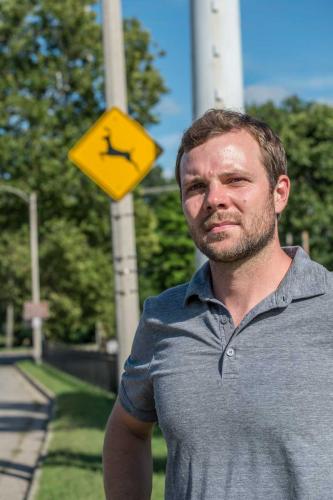 Nathan Snow, a 2014 doctoral graduate from the MSU Department of Fisheries and Wildlife and the Ecology, Evolutionary Biology and Behavior Program, was interested in knowing more about human-wildlife conflicts. Under the guidance of MSU professor William Porter, he dedicated his doctoral studies to understanding where WVCs occur and the environmental factors that increase their likelihood. He used data on three species of wildlife -- island foxes in California, white-tailed deer in the Midwest and moose in Maine -- to explore the issue.
Nathan Snow, a 2014 doctoral graduate from the MSU Department of Fisheries and Wildlife and the Ecology, Evolutionary Biology and Behavior Program, was interested in knowing more about human-wildlife conflicts. Under the guidance of MSU professor William Porter, he dedicated his doctoral studies to understanding where WVCs occur and the environmental factors that increase their likelihood. He used data on three species of wildlife -- island foxes in California, white-tailed deer in the Midwest and moose in Maine -- to explore the issue.
“Today’s technology has created new ways of collecting data on these collisions,” Snow said. “For instance, there are smart phone apps people can use to record collisions or to report dead deer on the road. This has given us access to a lot of data, but I was still left wondering, ‘Are they good enough to use in scientific research -- to actually understand what’s influencing where these collisions occur?’ Once we understand why they are occurring in certain locations, then we can make some decisions to mitigate them.”
Snow explained that about 50 percent of deer-vehicle collisions are not reported and, therefore, not captured in data.
“Lots of people hit deer, but sometimes the animal runs away, or people pick it up, put it in the car and take it home, never reporting it to the police,” he said. “I was concerned that this might skew the data we’re using to study the larger problem.”
Snow found that data on only about 30 percent of deer- and moose-vehicle collisions were needed to make reliable
inferences about the environmental variables influencing the location of the crashes. He also examined whether it was possible to define spots where collisions are more likely to occur.
“When we find a hotspot, we put out road signs that warn drivers to be careful, or we take some other sort of mitigation action,” he said. “But one of the things I think we’re lacking is a process to define and identify hotspots. When you look at the research, you’ll find that people define them in different ways.”
Historically, hotspots are defined by distance, which is subjective and sometimes arbitrary.
“We know that the landscape influences where WVCs occur, so I tried to use it to draw the boundaries around these areas,” Snow said. He found that when the landscape is used to define hotspots, they are much larger than previously thought.
Snow explained that every state in the U.S. deals with some sort of WVC, but the Midwest has some of the highest rates of these collisions. “Because it’s such a broad problem, I wanted to look at the broad-scale patterns of these collisions; no one has really explored that angle,” he said. “There’s been a lot of work to look at each specific collision location to try to identify why collisions occur there, but I wanted to explore why, for instance, southwestern Michigan has so many more collisions than northern Illinois, which has a similar landscape.”
His research analyzed county-level data from five Midwestern states across 12 years and revealed a phenomenon he calls “the suburb effect:” communities with suburban landscapes experience more collisions and more severe ones than other types of landscapes. Snow explained that deer live in close proximity to humans in suburban communities. Often, these communities infringe upon deer habitat, hunters don’t usually hunt in these areas, and traffic tends to be heavy in and surrounding these communities.
“In rural areas, there may be a lot of deer, but there just isn’t a lot of traffic, so there will be fewer collisions,” he concluded.
“But in suburban areas, you have the perfect storm of good habitat, a lot of deer and a lot of traffic. This phenomenon was consistent across all 12 years I analyzed. Knowing that helps me draw the conclusion that it may be worth investing in extensive, long-lasting mitigation efforts, such as building underpasses for wildlife to safely cross roads.”
Snow said he enjoyed his educational experience at MSU.
“The fisheries and wildlife department created a great environment for its students. Everyone was friendly and quick to help; they’re very concerned about your best interest. They want you to leave highly competitive and create lots of opportunities for you to do that. I definitely think my choice to attend MSU was worthwhile.”
In the summer of 2014, Snow accepted a position in Colorado as a postdoctoral researcher working on feral swine; it is a joint position between Texas A&M University and the U.S. Department of Agriculture.
Exploring the culture of venison sharing
Amber Goguen has always been interested in studying nature, but it wasn’t until she had the opportunity to travel and conduct fieldwork that she really began to see just how intertwined humans are with the environment. Through these experiences, Goguen — a dual master’s- and doctoral-degree student in the MSU Department of Fisheries and Wildlife under the guidance of MSU AgBioResearch professor Shawn Riley -- became deeply interested in exploring the intersection of wildlife, people and food.
“When it came time to find a mentor for graduate school, I contacted dozens of professors,” she explained. “Dr. Riley said he was looking for a student to ‘research the role of game meat consumption in attitudes toward hunting and environmental conservation.’ I couldn’t have asked for a better mentor or for a project more in line with my interests.”
Riley has done research in Sweden on the consumption of wild-harvested meat to examine how this influences non-hunter attitudes toward hunting.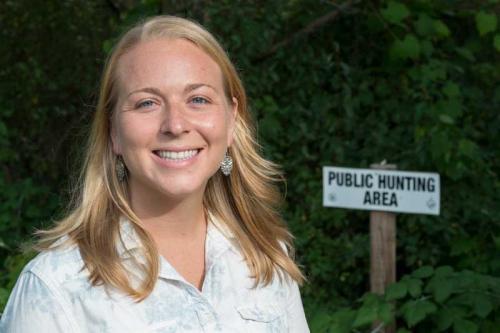
“Currently, Dr. Riley and I are conducting preliminary research on the extent of wild harvested meat consumption and sharing in Michigan for a larger project seeking to detect and quantify the effects of wild harvested meat consumption and sharing on society,” Goguen said. “We will be taking some of the methodologies developed in Michigan to Sweden to continue our research with colleagues there. Ultimately, we hope to compare the findings from both countries to determine the effect of governance structure and social norms on wild-harvested meat movement through society.”
Michigan is an archetypical state for white-tailed deer hunting in the Midwest. Deer are abundant and widely distributed throughout the state. White-tailed deer are one of the largest game species in the state, and 92 percent of Michigan hunters purchase deer licenses. In 2013, more than 660,000 Michigan hunters harvested an estimated 385,000 deer. Goguen estimates that the 2013 deer harvest produced 15 million to 25 million pounds of venison -- that equates to six to 10 meals per person, if the meat was distributed evenly to the entire population of the state.
Hunting is an important cultural tradition in Michigan and contributes funding to statewide wildlife conservation efforts. Maintaining the relevancy of hunting in an increasingly urbanized world can help ensure funding sources for conserving Michigan’s unique natural resources.
Goguen uses a research framework called “coupled human and natural systems” developed by MSU AgBioResearch scientist Jianguo “Jack” Liu, MSU University distinguished professor of fisheries and wildlife. The approach focuses on the patterns and processes that link human and natural systems, emphasizing the effects of humans on the environment and vice versa. Goguen is identifying the ecosystem services that consuming and sharing venison provide to Michiganders in addition to assessing the effect of these ecosystem services on society. Collecting this data will enable researchers and wildlife management agencies to better understand the suite of benefits hunting provides and to gauge its influence in shaping the public’s attitudes concerning the relevancy of hunting.
By surveying and interviewing Michigan deer hunters, Goguen is examining the extent, mechanism and effect of venison sharing on society. She explained that measuring “extent” involves determining how far harvested venison is transported.
“Where does it go?” she asks. “How much do the hunter and his/her family consume? Do they give it to relatives? Friends? Food banks? We want to know about all of the ways that Michigan venison is consumed and shared. We’re trying to understand who it’s going to and why it’s going to that particular person.”
The interviews have already begun to paint a picture of what some of the societal effects might be, but Goguen knows there is more work to be done. Two studies from Sweden found that the frequency of wild harvested meat consumption positively influenced attitudes toward hunting. Goguen wants to repeat the studies in Michigan but first needs to better understand the system.
“As a whole, the research findings have generally been pointing to the positive results of deer hunting in Michigan,” she explained. A survey of Michigan hunters found nearly half of hunters reported sharing venison in the past 12 months. Another survey found that nearly two out of every five non-hunters had consumed venison in the past 12 months.
“During interviews with Michigan deer hunters, I have heard hunters talk about having a responsibility for the kill – if they shoot the animal, they’re committed to using it in some way,” she said. “They also benefit from the harvest -- they have access to a lean protein source that doesn’t cut into their grocery budgets; some experience spiritual benefits and feel good about being able to support people in their communities by sharing their harvest; others explain that it improves their social relationships because of the bonding that hunting creates.”
Goguen said she is grateful for the experience.
“I have really enjoyed working with the graduate students, MSU faculty and the Michigan Department of Natural Resources. The connection between the university and this state agency is truly unique and lends itself to producing interesting, relevant research with direct applications to the conservation of state natural resources.”
Goguen is attending MSU on a University Enrichment Fellowship and National Science Foundation Graduate Research Fellowship and has been able to conduct this research with support from the Michigan DNR and the Safari Club International Michigan Involvement Committee.



 Print
Print Email
Email




